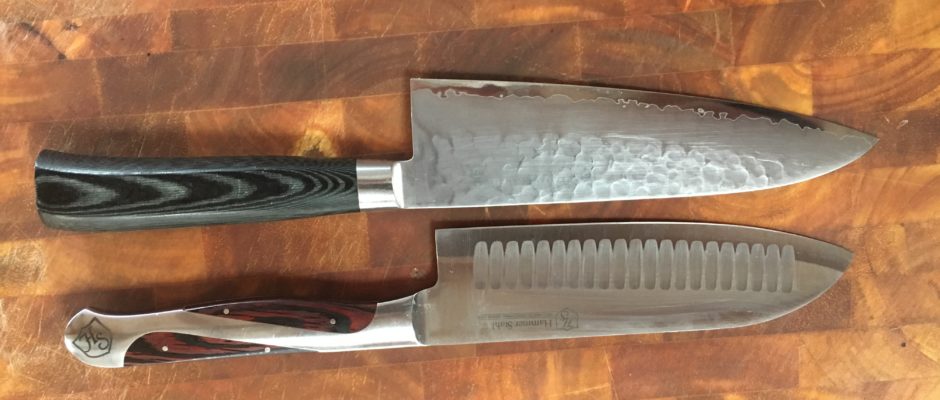As we have mentioned before, when traveling we try to find places to stay that have a kitchen so we can cook for ourselves local food. Knifes are problematic in most furnished places. Either they don’t have any or what they have is so dull you might as well cut with your finger. As a result, I travel with a minimal amount of kitchen items, including a couple of knives.
On our last trip, I came across a good deal on a Hammer Stahl 5 ½ inch Santoku style knife and it included a sharpener, so I picked it up for our trip. I like the Santoku style, and especially liked the way they have the scallops or recesses on the blade. The theory is that the recesses create air pockets and those help reduce sticking of what is being cut and friction. On most knives I have used, I would give a mixed review of the effectiveness of the scallops on the blade. But the Hammer Stahl Santoku has a lot of recesses and they are long. I was very curious as to the effectiveness of way they did theirs. But I am getting ahead of myself…
A bit about the purpose of this style of knife, if you aren’t familiar with them. Santoku is a Japanese style knife with three purposes, slicing, dicing, and mincing vegetables. I for one really enjoy this style of knife for those purposes, and have for several years. Back to the review…
The Hammer Stahl Knife is very attractive in its design, both the handle and the recesses in the blade. It cleans easier than I expected with those recesses, but does require a brush if the knife is not cleaned immediately after use. By that I mean, if you let things dry on the knife before cleaning, it took longer than other knives to clean because of the deep recesses. We try to always clean knives immediately after being used, but occasionally, we miss one or get busy doing other things. The main point here is that this knife is as easy to clean as any other knife, unless you let material dry on the knife, especially in the recess on the blade.
Since I have been talking about the recesses I might as well continue to give my impressions of their usefulness. I was very happy using it to slice and dice things. It performed very well on slicing aged Cheddar Cheese. When I use knifes on cheese, no matter what style, it sticks to the blade and you must either scrape it off with another blade or you end up making a mess out of it. But, with the Hammer Stahl, because of the deep recesses in the blade, cheese almost always came of cleanly and without issues. It wasn’t as good as a true cheese knife, but close for sure.
Sharpness and maintaining an edge was very good with this knife. I don’t hone with every use, but do frequently. To test this knife, I purposely used it longer than I normally would just to see how it held up. I used it until I felt it was losing its edge and then honed it. After a few strokes, it was back to its sharp level and I continued. Bottom line, it seems to hold its edge very well.
The handle as I said is very attractive and feels good in your hand when working the knife. But, I did have an issue with the handle. I use a raised wood cutting board and to chop and dice I had to keep the handle off the edge of the board. If I kept the whole knife on the board I banged my fingers on the board with each cutting stroke. In fairness, it might be ok on one of their larger knifes, because the blade would be deeper and provide more room for fingers. I can tell you I have other Santoku’s from other manufacturers that are the same size, and I have no problems with them.
Summary of Review;
Pluses
• Very attractive knife
• Maintains a good edge
• Blade recesses work well
Minuses
• Smallish handle that doesn’t have enough clearance for your fingers.
• Don’t let material dry on the knife before you clean it. If you do you will have extra work cleaning it.
Overall it is a useful knife, but not for as many uses as I like for my knives. The handle is the main limiting factor. I don’t see it replacing any of my other knives and would want to have my hands on one of their other knives before I would think about another one, so I could see how the handle works for cutting and the like.






Comments are closed.